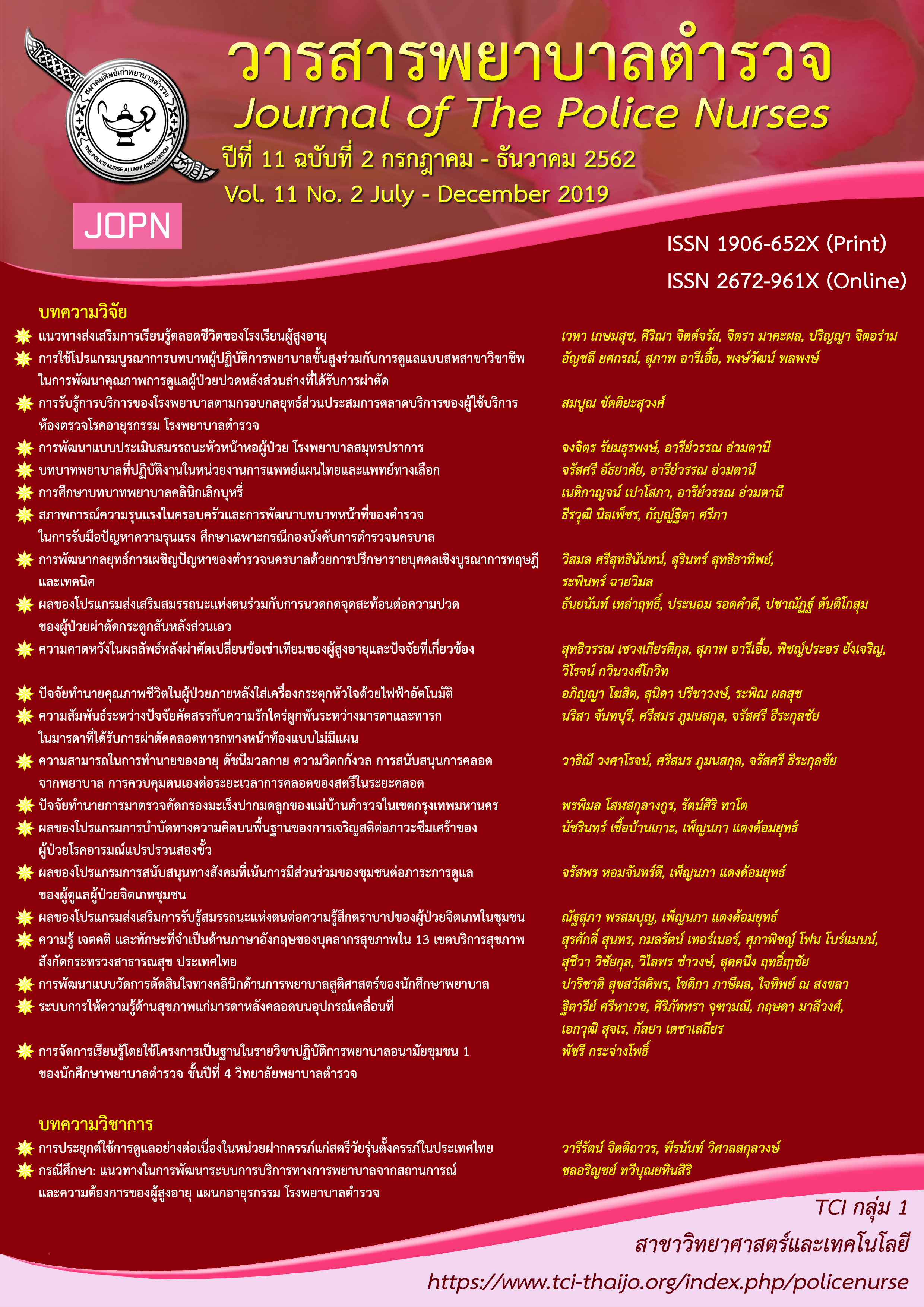DOMESTIC VIOLENCE SITUATION AND POLICE ROLE DEVELOPMENT IN DEALING WITH VIOLENCE: A CASE STUDY OF METROPOLITAN POLICE DIVISION 9
Keywords:
domestic violence, police role, dealing with violenceAbstract
The purpose of this research was to study the conditions, patterns, routes and conditions of domestic violence problems, the roles and problems of police officers, and the guidelines for the development of police roles focusing on integrating cooperation from all relevant sectors. Qualitative research methodology had been used. Data were collected from in-depth interviews of key informants, including domestic violence victims, police officers from Metropolitan Police Division 9and officers or persons related to the law enforcement process or persons with experience related to domestic violence issues. The tools used in the study were semi-structured interviews and behavior observation.
The results of the research on the severity of the situation showed that (1) There were more victims of domestic violence; (2) More violent actions had been inflicted; (3) A variety of violent characteristics had been found varying according to age and (4) domestic violence and alcohol and drug use often came together. Violence forms included physical, mental and sexual violence. The path of domestic violence started from harmonious family relationship and was constantly intensified by the use of harsh words and physical assaults. The victims might be abused only once or repeatedly, and they could break out of the cycle of violence when seeking help. There were factors that caused single domestic violence and repeated domestic violence. In order to develop the role of the police and integrate cooperation from various sectors, the role of the police should be developed in all 5 areas, namely (1) service, investigation and prosecution (2) prevention and suppression (3) prevention campaigns (4) a specialized unit to handle domestic violence cases and (5) development of education and training for police. Integrating cooperation with network agencies and creating a network of cooperation in the community should be promoted.
Downloads
References
Bandura, A. (1986). Social foundations of thought and action: A social cognitive theory. Englewood Cliffs, NJ: Prentice Hall.
Bograd, M. (1988). Feminist perspective on wife abuse. California: SAGE.
Bhatanapraphabhan, D., & Kongsakon, R. (2007). Community survey of problems and psychological consequences of domestic violence. Journal of Psychiatric Association of Thailand, 52(4). Retrieved from https://www.kmutt.ac. th/jif/public_html/article_detail.php?ArticleID=47322
Chafetz, J. S. (1997). Feminist theory and sociology: Underutilized contributions for mainstream theory. Annual Review of Sociology, 23, 97-120.
Chongwattana, S. (2009). Problems in the enforcement of domestic violence victim protection act, 2007 (Master of arts). Thammasart University. Bangkok.
Department of Women’s Affairs and Family Development, Ministry of Social Development and Human Security. (2017). Domestic violence, domestic violence: The truth and pathway. Retrieved from https://www.pptvhd36.com /news/.
Eshleman, J. R. (1994). The family: An Intersection (7th ed.). Boston: Allyn & Bacon, Incorporated.
Freud, S. (1964). Group psychology and the analysis of the ego Sigmund Freud. New York, NY: Bantam Books.
Gelles, R. J., & Straus, M. A. (1979). Determinants of violence in the family: Toward a theoretical integration. in W. R.
Burr, R. Hill, F. I. Nye, & I. L. Reiss (Eds.), Contemporary theories about the family (vol. 1), pp. 549-581. New York, NY: The Free Press.
Goode, W. (1971). Force and violence in the family. Journal of Marriage and the Family, 33, 624–636.
Giles-Sims, J. (1983). Wife battering: A systems theory approach. New York, NY: Guilford Press.
Hightower, J. (2004). Age, gender and violence: Abuse against older woman. Geriatrics & Aging, 7(3), 60-63.
Hill, R., & Mattessich, P. (1979). Family development theory and life span development. In P. Baltes, & O. Brim, (Eds.), Life span development and behavior (Vol. 2, pp. 161-204). New York, NY: Academic Press.
Homans, G. C. (1961). Social behavior. New York, NY: Harcourt Brace.
Hutapead, B. (2009). Research report on attitudes and roles of multidisciplinary teams towards solving domestic violence problems. Office of Women's Affairs and Family Institute. Sukhothai Thammathirat Open University.
Intharajit, O, & Krinchai, N. (2010). Women and children: Domestic violence victims. Bangkok: Hotline Psycho- logy Institute.
Jiamtae, P. (2012). Definitions and legal measures of domestic violence: A comparative study (Master’s thesis). Thammasat University, Faculty of Law, Field of Criminal Law.
Jitsawang, N. (1996). Criminology and Penology. Nonthaburi: Sukhothai Thammathirat Open University Press Office.
Ministry of Social Development and Human Security. (2018). Social and security situation report, 2018, 2nd quarter (April-June) presented to the cabinet. Retrieved from https://www.m-society.go.th/download/article/article _20180530120954.pdf.
Narongsak, A. (2009). Assessment of the enforcement of domestic violence victims protection act, 2007. Mahidol University. Nakhon Pathom.
Parmar, A., & Sampson, A. (2007). Evaluating domestic violence initiatives. The British Journal of Criminology, 47(4),
671-691.
Piyakawinyuakul, W., et al. (2003). The evaluation of justice in the protection of domestic violence victims. Research Report. Health Systems Research Institute.
Pongpan-anoosorn, W. (2013). Critical problem resolution of family violence throughout the protection of the victim of family violence act B.E. 2550 (Master’s Thesis). Mahidol University, Faculty of Social sciences and Humanities, Field of Criminology and Criminal Justice.
Reid, S. T. (1997). Crime and criminology (8th ed.). New York, NY: Brown & Benchmark Publishers.
Ritzer, G., & Goodman, D. J. (2004). Modern sociological theory. Boston: McGraw Hill.
Sanprasit, Y. (2011). Domestic violence prevention model with participatory action of families and community a case study of a community in Pathumthani province (Doctoral Dissertation). Srinakharinwirot University, Behavioral Science Research Institute, Field of Applied Behavioral Science Research.
Straus, M. A. (1973). A General systems theory approach to a theory of violence between family members. Social Science Information, 12(3), 105-125.
The Secretariat of The House of Representatives. (2011). Domestic violence: The law help. Bangkok: Bureau of
Parliamentary Studies, The Secretariat of The House of Representatives.
Wetwithan, P. (2014). An introduction to family theories. Bangkok: Parbpim.
Downloads
Published
How to Cite
Issue
Section
License
ผลงานที่ได้ตีพิมพ์แล้วจะเป็นลิขสิทธิ์ของวารสารพยาบาลตำรวจ















